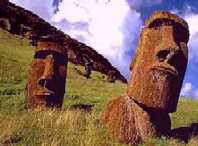
Today’s Tour Guide: Musclebunny
Easter
Island
Easter Island is over 2,000 miles from the nearest
population center, (Tahiti and Chile), making it one of
the most isolated places on Earth. A triangle of volcanic
rock in the South Pacific - it is best known for the
giant stone monoliths, known as Moai, that dot the
coastline. The early settlers called the island "Te
Pito O Te Henua" (Navel of The World). Admiral
Roggeveen, who came upon the island on Easter Day in
1722, named it Easter Island. Today, the land, people and
language are all referred to locally as Rapa Nui.
There has been much controversy and confusion concerning
the origins of the Easter Islanders. Thor Heyerdahl
proposed that the people who built the statues were of
Peruvian descent, due to a similarity between Rapa Nui  and Incan
stonework. Some have suggested that Easter Island is the
remnant of a lost continent, or the result of an
extra-terrestrial influence . Archaeological evidence,
however, indicates discovery of the island by Polynesians
at about 400 AD - led, according to legend, by Hotu
Matua. Upon their arrival, an impressive and enigmatic
culture began to develop. In addition to the statues, the
islanders possessed the Rongorongo script; the only
written language in Oceania. The island is also home to
many petroglyphs (rock carvings), as well as traditional
wood carvings, tapa (barkcloth) crafts, tattooing, string
figures, dance and music. and Incan
stonework. Some have suggested that Easter Island is the
remnant of a lost continent, or the result of an
extra-terrestrial influence . Archaeological evidence,
however, indicates discovery of the island by Polynesians
at about 400 AD - led, according to legend, by Hotu
Matua. Upon their arrival, an impressive and enigmatic
culture began to develop. In addition to the statues, the
islanders possessed the Rongorongo script; the only
written language in Oceania. The island is also home to
many petroglyphs (rock carvings), as well as traditional
wood carvings, tapa (barkcloth) crafts, tattooing, string
figures, dance and music.
he population of Easter Island reached its peak at
perhaps more than 10,000, far exceeding the capabilities
of the small island's ecosystem. Resources became scarce,
and the once lush palm forests were destroyed - cleared
for agriculture and moving the massive stone Moai. In
this regard, Easter Island has become, for many, a
metaphor for ecological disaster.
 Thereafter, a
thriving and advanced social order began to decline into
bloody civil war and, evidently, cannibalism. Eventually,
all of the Moai standing along the coast were torn down
by the islanders themselves. All of the statues now
erected around the island are the result of recent
archaeological efforts. Thereafter, a
thriving and advanced social order began to decline into
bloody civil war and, evidently, cannibalism. Eventually,
all of the Moai standing along the coast were torn down
by the islanders themselves. All of the statues now
erected around the island are the result of recent
archaeological efforts.
Contacts with western "civilization" proved
even more disastrous for the island population which,
through slavery and disease, had decreased to
approximately 111 by the turn of the century. Following
the annexation by Chile in 1888, however, it has risen to
more than 2,000, with other Rapanui living in Chile,
Tahiti and North America. Despite a growing Chilean
presence, the island's Polynesian identity is still quite
strong .
Easter Island today, remains one of the most unique
places you will ever encounter; an open air museum
showcasing a fascinating, but unfortunately lost,
culture. The Rapanui are among the friendliest people you
will ever meet, and the landscape is truly amazing - with
its volcanic craters, lava formations, beaches, brilliant
blue water, and archaeological sites.
|